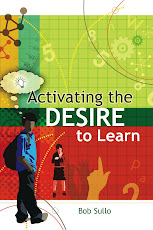As someone who provides staff development, it has been my
experience that most professional development is driven by a single personality
within a school or district. While there are an increasing number of schools
who delegate decision-making to a staff development committee, it remains more
common for the course to be charted by one individual, often the building
principlal. For example, if a building principal reads one of my books or hears
me present at a national conference and develops an interest in internal
control psychology/choice theory, they may engage me to work with their staff
over a period of time. While “over a period of time” is head and shoulders
ahead of the
“drive by” staff development I wrote about recently, too
much staff development is personality driven as opposed to system driven. Let
me give an example to illustrate what I mean.
Several years ago, I was contacted by an elementary school
principal who had read
Activating the Desire to Learn. Over the next three school years, I provided
a series of staff development sessions at her school that included summer
workshops, multi-day workshops, and regular visits to the school that included
meeting with teachers, visiting classrooms, and modeling lessons. Even though
I’m not a big fan of NCLB and AYP, I was pleased that our efforts contributed
to the school achieving AYP every year we worked together. (It’s worth
mentioning that there are over two dozen schools in the district and this was
one of only two to make AYP last year.) My work on internal motivation, student
engagement, and choice theory was woven into other staff development
initiatives so that teachers received integrated professional development.
Because the school provided comprehensive staff development and ongoing
coaching to teachers, they had a lot of well-deserved success.
But…. (all to often there’s a “but,” isn’t there?)….the
principal left. The incoming principal has her own ideas. I don’t know how
closely they align with what we have done the past three years. I do know that principals are granted considerable autonomy, charged with “putting their
stamp” on a school. It will not be surprising if this principal charts her own,
different course.
Unless practices are formally adopted by a district, schools
will continue to repeat the cycle of improvement, change in leadership, and
change in direction. It takes a lot of effort and willpower to raise things to
the level of district policy. That’s why most schools don’t do it. Years ago I
worked with a district in upstate New York. They stood out because they took
the choice theory principles we worked on together and wove them into the
district mission statement. That ensured that the ideas would continue even
after an energetic, passionate principal left the district.
If you want your staff development to be more than a
reflection of the personality leading a school or district, consider how you
can incorporate key ideas and applications into formal policy. When you start
looking at staff development as something that impacts policy, you’ll begin to
take it more seriously, carefully consider what it is you want to pursue, and
give your school/district tools to effect change extending beyond the
personality of an engaging leader.
As always, if you enjoyed this and found it useful, please
send the link to your friends. Thanks.
Bob Sullo
PO Box 1336
Sandwich, MA 02563
For information about books by Bob Sullo and to schedule a
keynote, workshop, or series for your school, agency, or parent group visit
www.internalmotivation.net






To be a student is quite a hard work. One of the most tough thing is to keep being motivated. I've found an interesting article abour motivation for Harvard students:
ReplyDelete15 Rules of Motivation